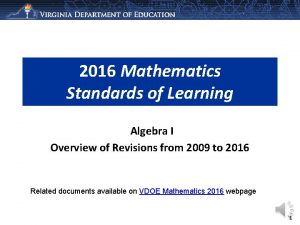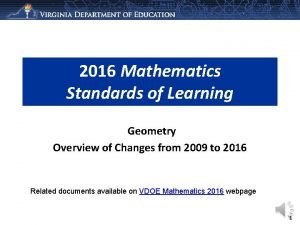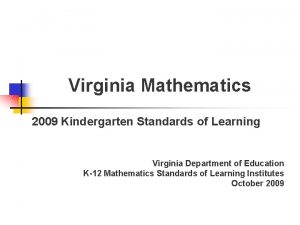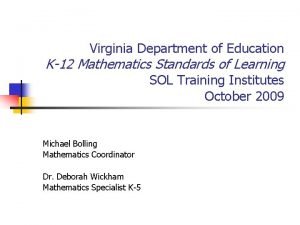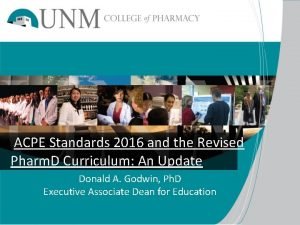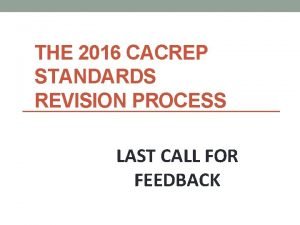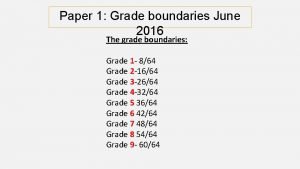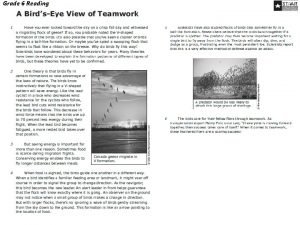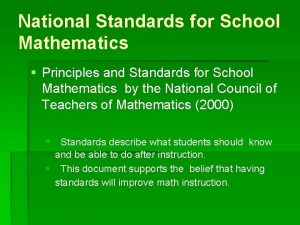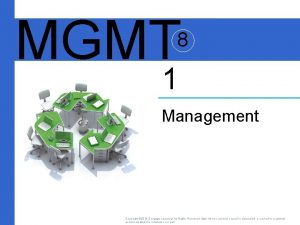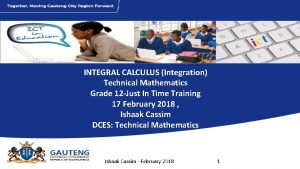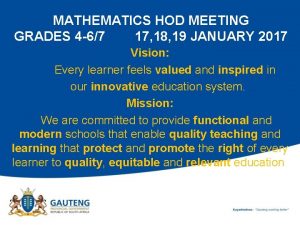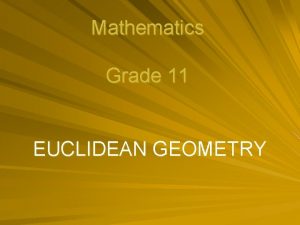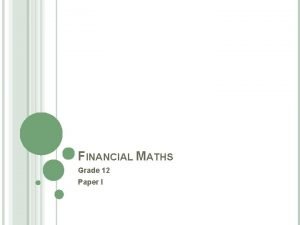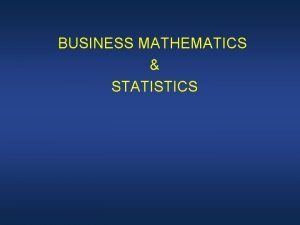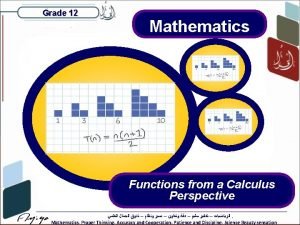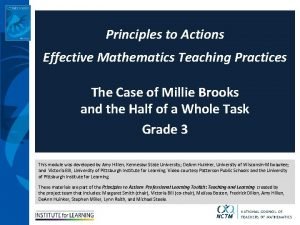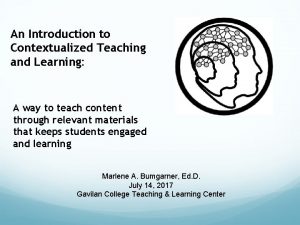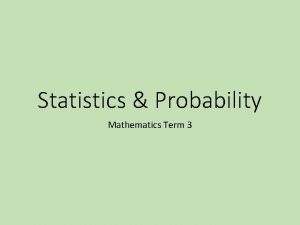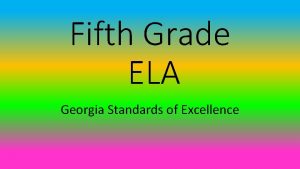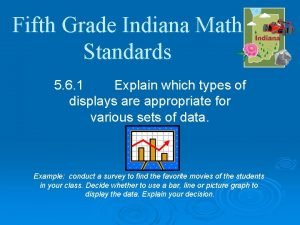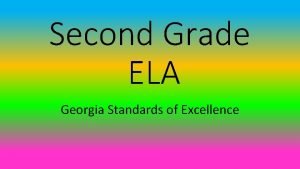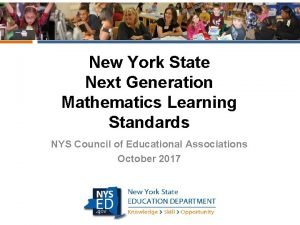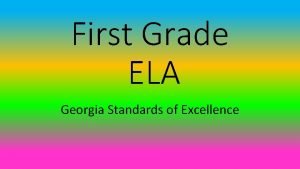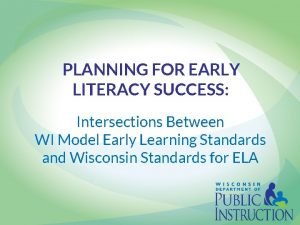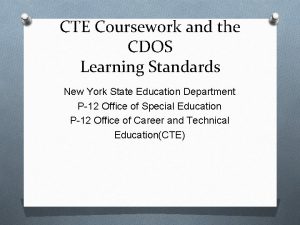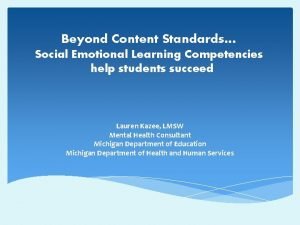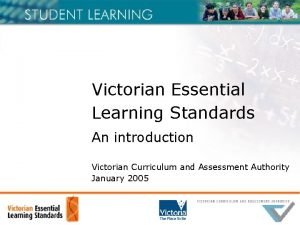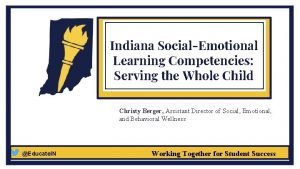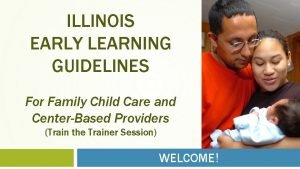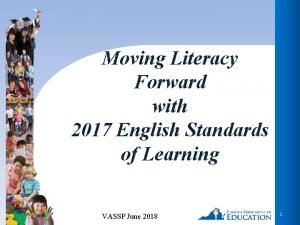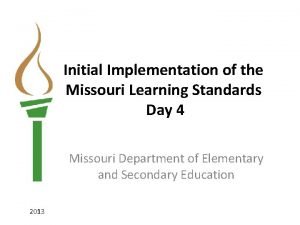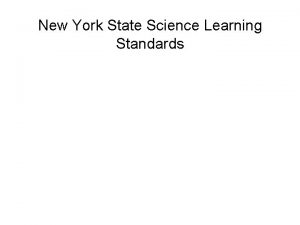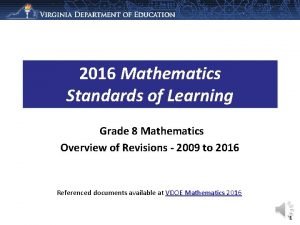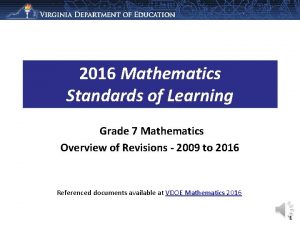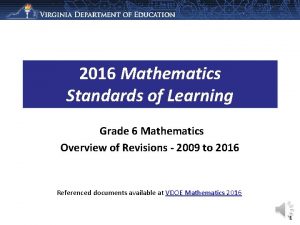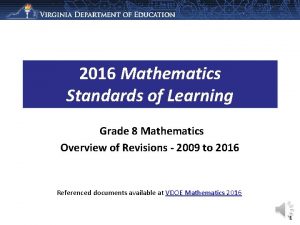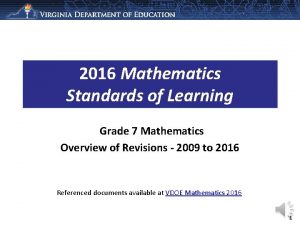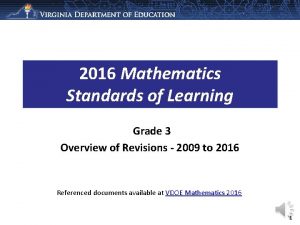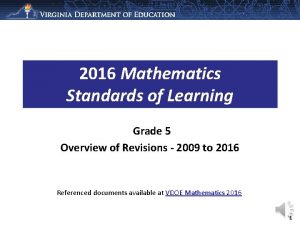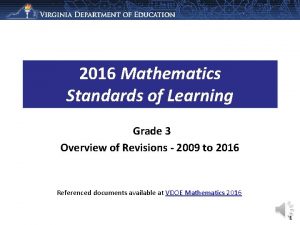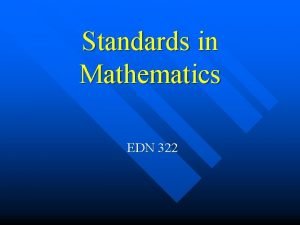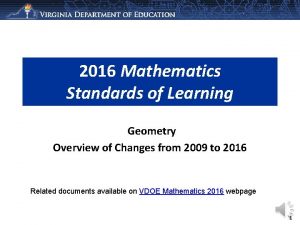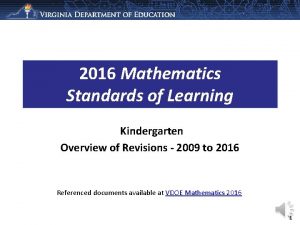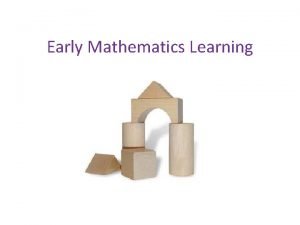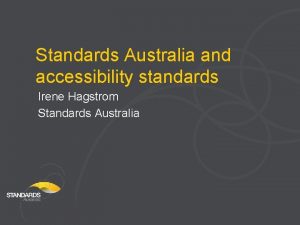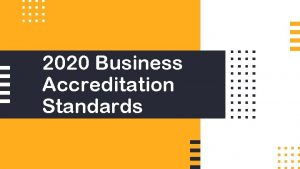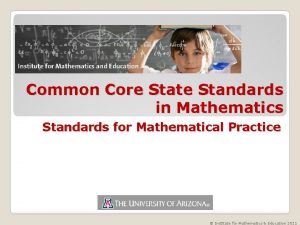2016 Mathematics Standards of Learning Grade 7 Mathematics





































- Slides: 37

2016 Mathematics Standards of Learning Grade 7 Mathematics Overview of Revisions - 2009 to 2016 Referenced documents available at VDOE Mathematics 2016 1

Purpose • Overview of the 2016 Mathematics Standards of Learning and the Curriculum Framework • Highlight information included in the Essential Knowledge and Skills and the Understanding the Standard sections of the Curriculum Framework 2

Agenda • Implementation Timeline • Resources Currently Available – Crosswalk (Summary of Revisions) – Standards and Curriculum Frameworks • Comparison of 2009 to 2016 Standards – – – Number and Number Sense Computation and Estimation Measurement and Geometry Probability and Statistics Patterns, Functions, and Algebra 3

Implementation Timeline 2016 -2017 School Year – Curriculum Development VDOE staff provides a summary of the revisions to assist school divisions in incorporating the new standards into local written curricula for inclusion in the taught curricula during the 2017 -2018 school year. 2017 -2018 School Year – Crossover Year 2009 Mathematics Standards of Learning and 2016 Mathematics Standards of Learning are included in the written and taught curricula. Spring 2018 Standards of Learning assessments measure the 2009 Mathematics Standards of Learning and include field test items measuring the 2016 Mathematics Standards of Learning. 2018 -2019 School Year – Full-Implementation Year Written and taught curricula reflect the 2016 Mathematics Standards of Learning assessments measure the 2016 Mathematics Standards of Learning. 4

2016 SOL Revisions – • Improve the vertical progression of mathematics content • Ensure developmental appropriateness of student expectations • Increase support for teachers in mathematics content (including definitions, explanations, examples, and instructional connections) • Clarify expectations for teaching and learning • Improve precision and consistency in mathematical language and format • Ensure proficiency of elementary students in computational skills 5

Changes to the Curriculum Framework • Reduction of columns from 3 to 2 – Understanding the Standard (US) – information that supports mathematical content knowledge – Essential Knowledge and Skills (EKS) – information that provides expectations for student learning • Indicators of SOL sub-bullet added to each bullet within the Essential Knowledge and Skills • Objectives measured without a calculator on state assessments are indicated with an asterisk * 6

7

Overview – Math 7 2009 Strand 2016 # of Standards Number and Number Sense 2 1 Number and Number Sense Computation and Estimation 2 2 Computation and Estimation Measurement 2 Geometry 2 4 Measurement and Geometry Probability and Statistics 3 2 Probability and Statistics Patterns, Functions, and Algebra 5 4 Patterns, Functions, and Algebra 16 13 Total Strand Total 8

Mathematics Process Goals for Students “The content of the mathematics standards is intended to support the five process goals for students” - 2009 and 2016 Mathematics Standards of Learning Communication Connections Problem Solving Representations Mathematical Understanding Reasoning 9

Standards of Learning Curriculum Frameworks Introduction includes: • Mathematical Process Goals for Students • Instructional Technology New • Computational Fluency • Algebra Readiness • Equity 10

2009 2016 11

12

NUMBER AND NUMBER SENSE 13

2009 SOL 7. 1 The student will a) investigate and describe the concept of negative exponents for powers of ten; b) determine scientific notation for numbers greater than zero; * c) compare and order fractions, decimals, percents, and numbers written in scientific notation; * d) determine square roots; * and e) identify and describe absolute value for rational numbers. 2016 SOL 7. 1 The student will a) investigate and describe the concept of negative exponents for powers of ten; b) compare and order numbers greater than zero written in scientific notation; * c) compare and order rational numbers; * d) determine square roots of perfect squares; *and e) identify and describe absolute value of rational numbers. Revisions: • Compare and order no more than four numbers written in scientific notation; convert between a number written in scientific notation and decimals • Compare and order rational numbers (positive/negative) expressed as integers, fractions (proper/improper), mixed numbers, decimals, and percents • Determine the absolute value of a rational number *On the state assessment, items measuring this objective are assessed without the use of a calculator. 14

2009 SOL 2016 SOL 7. 2 The student will describe and represent arithmetic and geometric sequences, using variable expressions. [Included in AFDA. 1 EKS and AII. 5] Revisions: • Removed from Grade 7 and included in AFDA. 1 EKS and AII. 5 15

COMPUTATION AND ESTIMATION 16

2009 SOL 2016 SOL New 7. 2 The student will solve practical problems involving operations with rational numbers. Revisions: • Solve practical problems involving operations with rational numbers 17

2009 SOL 2016 SOL 7. 3 The student will a) model addition, subtraction, multiplication, and division of integers; and [Moved to 6. 6 a EKS] b) add, subtract, multiply, and divide integers. * [Moved to 6. 6 a] Revisions: • Removed from Grade 7 and included in SOL 6. 6 18

2009 SOL 2016 SOL 7. 4 The student will solve single-step and multistep 7. 3 The student will solve single-step and multistep practical problems, using proportional reasoning. Revisions: • Create and use a ratio table to determine missing values in a proportional relationship • Apply proportional reasoning to convert units of measurement given the conversion factor [Moved from 6. 9] 19

MEASUREMENT AND GEOMETRY 20

2009 SOL 7. 5 The student will a) describe volume and surface area of cylinders; b) solve practical problems involving the volume and surface area of rectangular prisms and cylinders; and c) describe how changing one measured attribute of a rectangular prism affects its volume and surface area. [Included in 8. 6 b] 2016 SOL 7. 4 The student will a) describe and determine the volume and surface area of rectangular prisms and cylinders; and b) solve problems, including practical problems, involving the volume and surface area of rectangular prisms and cylinders. Revisions: • 7. 4 a – Determine the volume and surface area of a rectangular prism [Removed from Grade 6] and cylinder • 7. 5 c – Removed from Grade 7 and included in SOL 8. 6 21

2009 SOL 7. 6 The student will determine whether plane figures—quadrilaterals and triangles—are similar [Included in G. 7] and write proportions to express the relationships between corresponding sides of similar figures. 2016 SOL 7. 5 The student will solve problems, including practical problems, involving the relationship between corresponding sides and corresponding angles of similar quadrilaterals and triangles. Revisions: • Determine unknown side lengths or angle measures, given two similar quadrilaterals or triangles • Solve a proportion to find a missing side length of similar quadrilaterals and triangles 22

2009 SOL 7. 7 The student will compare and contrast the following quadrilaterals based on properties: parallelogram, rectangle, square, rhombus, and trapezoid. 2016 SOL 7. 6 The student will a) compare and contrast quadrilaterals based on their properties; and b) determine unknown side lengths or angle measures of quadrilaterals Revisions: • Properties of quadrilaterals were removed from grade 6 • Determine unknown side lengths or angle measures of quadrilaterals, using properties of quadrilaterals 23

2009 SOL 2016 SOL 7. 8 The student, given a polygon in the coordinate 7. 7 The student will apply translations and plane, will represent transformations reflections of right triangles or rectangles in the (reflections, dilations [Included in 8. 7 a and G. 3], coordinate plane. rotations [Included in G. 3], and translations) by graphing in the coordinate plane. Revisions: • Removed from Grade 7 - Transform a figure using dilation [Included in 8. 7] and rotation [Included in G. 3] • Transformations of a right triangle or rectangle can include both translation and then reflection over the x- or y-axis, or reflection over the x- or y-axis and then translation 24

PROBABILITY AND STATISTICS 25

2009 SOL 2016 SOL 7. 9 The student will investigate and describe the 7. 8 The student will difference between the experimental probability a) determine theoretical and experimental and theoretical probability of an event. probabilities of an event; and b) investigate and describe the difference between the experimental probability and theoretical probability of an event Revisions: • 7. 8 a -Determine theoretical and experimental probabilities of an event 26

2009 SOL 2016 SOL 7. 10 The student will determine the probability of compound events, using the Fundamental (Basic) Counting Principle. [Moved to 5. 15] Revisions: • Removed from Grade 7 and included in SOL 5. 15 27

2009 SOL 2016 SOL 7. 11 The student, given data for a practical situation, 7. 9 The student, given data in a practical situation, will a) construct and analyze histograms; and a) represent data in a histogram; b) compare and contrast histograms with other types of graphs presenting information from the same data set. b) make observations and inferences about data represented in a histogram; and c) compare histograms with the same data represented in stem-and-leaf plots, line plots, and circle graphs. Revisions: • Number of data values to construct a histogram is no longer limited • Observations/inferences about data represented in a histogram now part of the standard itself • Compare histograms with the same data represented in other graphs now specified as line plots, circle graphs, and stem-and-leaf plots 28

PATTERNS, FUNCTIONS, AND ALGEBRA 29

2009 SOL 2016 SOL 7. 12 The student will represent relationships with tables, graphs, rules, and words. [Included in 7. 10 e] New 7. 10 The student will a) determine the slope, m, as a rate of change in a proportional relationship between two quantities and write an equation in the form y = mx to represent the relationship; b) graph a line representing a proportional relationship between two quantities given the slope and an ordered pair, or given the equation in y = mx form, where m represents the slope as rate of change; Revisions: • 7. 10 a - Determine slope as rate of change and write an equations in y = mx form to represent a proportional relationship • 7. 10 b - Graph lines representing proportional relationships given the slope and an ordered pair or the equation y = mx • Examples added in the US 30

2009 SOL 2016 SOL New c) determine the y-intercept, b, in an additive relationship between two quantities and write an equation in the form y = x + b to represent the relationship; d) graph a line representing an additive relationship between two quantities given the y-intercept and an ordered pair, or given the equation in the form y = x + b, where b represents the yintercept; and e) make connections between and among representations of a proportional or additive relationship between two quantities using verbal descriptions, tables, equations, and graphs. Revisions: • 7. 10 c - Determine the y-intercept and write equations of lines in y = x + b form to represent the relationship • 7. 10 d - Graph lines representing additive relationships; y-intercept limited to integers and slope is 1 • 7. 10 e - Make connections among representations (verbal descriptions, tables, equations, and graphs) 31

2009 SOL 7. 13 The student will a) write verbal expressions as algebraic expressions and sentences as equations and vice versa; and [Included in 7. 12 EKS] b) evaluate algebraic expressions for given replacement values of the variables. 2016 SOL 7. 11 The student will evaluate algebraic expressions for given replacement values of the variables. Revisions: • Represent algebraic expressions using concrete materials and pictorial representations; • Evaluating expressions – limit exponents to 1, 2, 3, or 4; no braces, but can include brackets and absolute value; square roots limited to perfect squares 32

2009 SOL 7. 14 The student will a) solve one- and two-step linear equations in one variable; and b) solve practical problems requiring the solution of one- and two-step linear equations. 2016 SOL 7. 12 The student will solve two-step linear equations in one variable, including practical problems that require the solution of a twostep linear equation in one variable. [One-step equations included in 6. 13] Revisions: • One-step equations are included in 6. 13 • Coefficients and numeric terms will be rational • Apply properties of real numbers and properties of equality • EKS – Write verbal expressions and sentences as algebraic expressions and equations and vice versa [Moved from 7. 13 a] 33

2009 SOL 2016 SOL 7. 15 The student will a) b) 7. 13 The student will solve one- and two-step linear inequalities in one variable, including practical solve one-step inequalities in one variable; problems, involving addition, subtraction, and multiplication, and division, and graph the graph solutions to inequalities on the solution on a number line. Revisions: • Solve two-step inequalities and practical problems [Moved from 8. 15 b] • Solve one-step and two-step inequalities involving addition, subtraction, multiplication and division including practical problems • Coefficients and numeric terms will be rational • EKS – Write verbal expressions and sentences as algebraic expressions and inequalities and vice versa • EKS – Identify a numerical value that is part of the solution set of a given inequality • Apply properties of real numbers and properties of equality/inequality 34

2009 SOL 2016 SOL 7. 16 The student will apply the following properties of operations with real numbers: a) the commutative and associative properties for addition and multiplication; b) the distributive property; c) the additive and multiplicative identity properties; d) the additive and multiplicative inverse properties; and e) the multiplicative property of zero. [Included in EKS and US for 7. 11, 7. 12, and 7. 13] Revisions: • Moved to 7. 11, 7. 12 and 7. 13 Understanding the Standard • The focus is not to identify a specific property being used, but correctly apply the properties. 35

Middle School Revisions Leading to Algebra I 36

Questions? Please contact us! Mathematics@doe. virginia. gov 37
 Algebra 1 sol standards
Algebra 1 sol standards 2016 mathematics standards of learning
2016 mathematics standards of learning Virginia kindergarten standards
Virginia kindergarten standards Vdoe vertical articulation
Vdoe vertical articulation Acpe standards 2016
Acpe standards 2016 Cacrep 2016 standards
Cacrep 2016 standards Cuadro comparativo e-learning y b-learning
Cuadro comparativo e-learning y b-learning To a daughter leaving home and poem for my sister
To a daughter leaving home and poem for my sister 6th grade reading staar
6th grade reading staar Principles and standards for school mathematics
Principles and standards for school mathematics Mgmt+8
Mgmt+8 Hard customer defined standards
Hard customer defined standards Mathis grade 12
Mathis grade 12 Gplms
Gplms Grade 11 mathematics euclidean geometry
Grade 11 mathematics euclidean geometry Finance grade 12
Finance grade 12 Business math grade 11 ratio and proportion
Business math grade 11 ratio and proportion Mathematics functions grade 12
Mathematics functions grade 12 Establish mathematics goals to focus learning
Establish mathematics goals to focus learning Contextualized learning
Contextualized learning Learning intentions and success criteria for mathematics
Learning intentions and success criteria for mathematics Georgia standards of excellence ela
Georgia standards of excellence ela Indiana math standards
Indiana math standards Georgia reading standards 2nd grade
Georgia reading standards 2nd grade Nys next generation standards math
Nys next generation standards math Oklahoma state department of education math standards
Oklahoma state department of education math standards Elagse
Elagse Wmels 5 domains
Wmels 5 domains Cte programs of study
Cte programs of study Social emotional learning standards michigan
Social emotional learning standards michigan Victorian essential learning standards
Victorian essential learning standards Social emotional learning standards nj
Social emotional learning standards nj Idoe mtss
Idoe mtss Illinois early learning standards
Illinois early learning standards Social emotional learning washington state
Social emotional learning washington state 2017 english standards of learning curriculum framework
2017 english standards of learning curriculum framework How to write missouri learning standards
How to write missouri learning standards New york state learning standards science
New york state learning standards science
